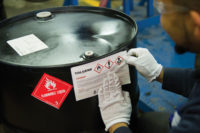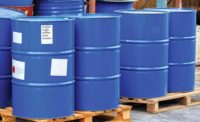The HCS requires that those most familiar with the hazards of the chemical — the companies that produce, import or distribute them — assess the hazards and convey this information to downstream users.
Chemical manufacturers, importers and distributors must ensure that containers of hazardous chemicals are labeled when shipped.
Container labels
Under HCS 2012, all shipped containers of hazardous chemicals must be labeled, tagged or marked with six specified label elements, four of which have been “harmonized” within the GHS system. Those required label elements are:
• Product identifier;
• Signal word;
• Hazard statement(s);
• Pictogram(s);
• Precautionary statement(s); and
• The name, address and telephone number of the chemical manufacturer, importer or other responsible party.
A label must be on the “immediate container” of every hazardous chemical.
If GHS uses nine pictograms, why does OSHA only use eight?
The GHS does include nine pictograms, one of which is used for environmental hazards. OSHA has no authority over environmental hazards and does not require the use of the environmental pictogram.
Will OSHA allow blank red borders?
HCS 2012 requires that all red borders printed on the label have a symbol printed inside it. Allowing blank red borders might confuse the reader, or imply that information is missing.
However, OSHA has said that blacking out unused red frames on a pre-printed label would be acceptable, as long as the red frame is fully covered and filled in.
Can I use a black border on pictograms?
If printing labels for in-house use, pictograms may have a black border. For labels on shipped containers, pictograms must have red borders regardless of whether the shipment is domestic or international.
Where can I find what label elements are required for a chemical?
Under the GHS system, the required label elements are predetermined based upon the chemical’s physical or health category and class. All of the required label elements will be found on the Safety Data Sheet (SDS) for that chemical in Section 2 Hazard(s) Identification.
What about small containers?
OSHA tells us that the all containers of hazardous chemicals leaving the workplace must be labeled with the required information. Even very small containers must be tagged or marked in a fashion that fulfills the intent of the standard.
Why aren’t we seeing more GHS-style labels?
OSHA has set the deadline for chemical manufacturers and importers to have updated labels and data sheets as June 1, 2015. All containers of hazardous chemicals shipped after June 1, 2015, must be labeled, tagged or marked with the OSHA-required GHS-style label elements.
Distributors may continue to ship containers labeled by manufacturers or importers (but not by the distributor themselves) in compliance with the HCS 1994 until December 1, 2015.
Workplace labeling
Containers of hazardous chemicals in the workplace must be labeled, and employers are responsible for maintaining those labels. This means that labels must continue to be legible and information on the hazards and directions for use may not be defaced, fade or get washed off, or otherwise be removed in any way.
What languages am I required to label in?
OSHA says that workplace labels must be in English, but employers are free to add warnings in other languages if workers would find that helpful. If shipping out of the United States, the shipper must follow the labeling laws of the country the chemical is being shipped to.
Do I have to re-label existing containers of chemical in my facility?
For containers that are already labeled from the supplier, simply maintaining the existing label is the best and easiest option.
You do not have to update labels on containers already in your facility, even if the containers are labeled under HCS 1994, unless you will be shipping them out of your facility. However, if you become aware of newly-identified hazards that are not disclosed on the label, you must ensure that the workers are made aware of the hazards. This is usually done through updated labels.
Can we still use in-plant labeling systems?
Employers may continue to use an in-plant or hazard ratings system that meets the requirements of HCS 1994, such as the National Fire Protection Association® (NFPA®) diamonds or the Hazardous Materials Identification System® (HMIS®) requirements for workplace labels as long as they are consistent with the requirements of the HCS and the employees have immediate access to the specific hazard information.
Aren’t the numbering systems for GHS and NFPA/HMIS reversed?
In HCS 2012 each physical and health hazard class may have several sub-categories, some as many as five. These categories are identified using a numbering system as well, with the number 1 indicating the most severe hazard of a given hazard class, and a 2, 3, 4, or 5 indicating the least severe hazard. For some sub-categories, letters are used (A through E for instance) or a combination of letters and numbers as in 1A, 1B, and 2.
NFPA/HMIS systems use a rating system of 0 through 4, with 4 representing the most serious hazard.
Doesn’t the reversed numbering create a conflict?
When OSHA says that an in-house labeling system may not “conflict” with the revised HCS, the Agency is not referring to the hazard rating numbering systems. OSHA has said that there is not a conflict because the GHS is a hazard classification system while NFPA and HMIS are hazard assessment systems.
Also, HCS 2012 hazard category numbers do not appear on shipped container labels, so OSHA tells us there shouldn’t be any issues.
How does HCS 2012 affect portable containers?
There is no change to the labeling requirements for portable containers. You are not required to label portable containers into which hazardous chemicals are transferred from labeled containers, and which are intended only for the immediate use of the employee who performs the transfer.


